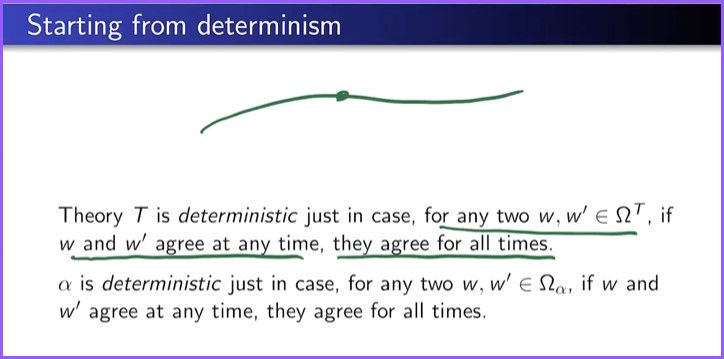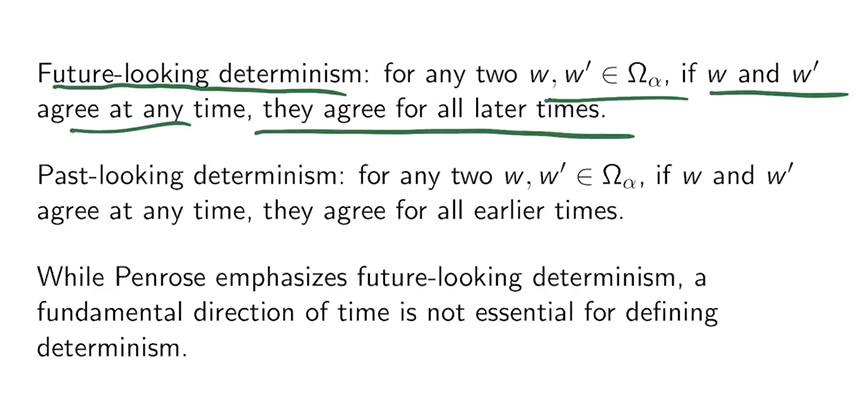When do you have strong determinism in Quantum Mechanics? When you have many worlds?
- Dr Bruce Long

- Mar 29, 2022
- 7 min read
Updated: Mar 29, 2022
Eddy Kemming-Chen has recently proposed strongly deterministic (SD) interpretation of a quantum mechanical model of how the universe and all of its events evolve (i.e. develop, unfold, or ‘roll out’) over time. His proposal replaces the Everettian mentaculus - which is based upon a probability distribution of a wave function (considered as real) and initial conditions - with an adaptation he calls the Everettian Wentaculus. The ‘Kemming-Chen Wentaculus’ replaces the wave function distribution with a (probability) density matrix that is taken to be real (i.e. realism about the density function as something that exists in the world/universe) and is taken to define and encapsulate an initial, total, mixed ontic state of the universe including all of its initial conditions and fundamental laws (with not much going on initially).
Why? Kemming-Chen’s Wentaculus is supposed to solve an alleged problem associated with SD intrinsic to the many worlds interpretation (MWI) of quantum mechanics (QM) due to Hugh Everett. According to Everett's MWI interpretation of QM, each quantum state and each state of the universal wave function (the wave function that models the evolution of the entire universe system from its inception) can – and do – give rise to an infinite number of possible wave function evolutions: different universes. According to Kemming-Chen’s conception of SD, Everett's approach is therefore not strongly deterministic.
I currently don’t think this denial of SD for Everett's WMI works because it neglects to include chaos theory as part of – or part of the constraints upon - the initial conditions and the universal wave function.
Kemming-Chen proposes that the Everett MWI is not strongly deterministic since it allows for many sets (a probability distribution) of initial conditions and many possible real wave functions - and their evolutions or ‘temporal roll outs’ - such that universal nomic constraints and the distribution of wave functions do not determine that the universe will be the same in all possible worlds. However, I still feel there’s a possible problem for Kemming-Chen’s assertion that Everett's characterisation is thus not SD. I don’t feel it is intuitively 'secure' that SD necessarily means that all possible worlds must roll out – their systems physico-mathematically evolve - exactly the same way.
This seems non-sensical, perhaps. However it does not seem as plainly nonsensical when one considers SD plus randomness. More specifically - when one considers SD plus chaos and strange attractors, which Kemming-Chen relies upon as an explanatory tool.
In his talk Kemming-Chen refers to an icon of chaos theory (the Mandelbrot set) which is a way of characterising the diverging additive bifurcations of certain strange attractors evolving over time. i.e. Chaos theory. (The Mandelbrot set is one kind of fractal representation of a strange attractor.) He does so to contrast his conception of strong determinism and Everett's.
Everett's mathematical scheme of MWI allows for infinitely many ‘roll-outs’ from each quantum event. This is not strong determinism according to Kemming-Chen’s conception thereof, which requires that there can only be one real evolution of the universe system and the wave function (or in this case – density matrix) that describes it. There is some haggling over the value of mathematical conceptions of determinism versus physico-mathematical and physical conceptions thereof, but I will not engage with that in detail here. (It's a noisy enough marketplace of ideas in which to trade already.)
I think Kemming-Chen’s very sexy Mandelbrot approach explains things the beautiful-and-clever-but-hard way. So here’s the easy way that refers instead to butterflies and the wonderful Lorenz attractor of meteorologist Ed Lorenz. I will give only the briefest explanation of an attractor. Ready? Physicists mathematically represent the way a physical system and its variables develop by using phase spaces, which are a kind of (often 3 dimensional) graph. Many physical systems have parameters and properties that mean there will be a certain path, or trajectory, in the phase space that they are expected to follow in their development over time, or their evolution. For linear deterministic systems this trajectory in phase space - the attractor - is always the same and perfectly predictable.
However, we're not talking about those kinds of predictable systems here. We're talking about naughty chaotic systems that have trajectories that are infinitely random within certain boundaries. These are strange attractors. To get a simple idea of this bounded strange attractor concept: a particle (a simple physical system) might have a bottom speed and a top speed for each point on its path, but it can go at any number of an 'infinite' number of possible speeds in between. There's no way of knowing which speed it will 'choose' at that point until you're very close to that point. The further before the point the particle is in its journey around its trajectory in phase space, the less hope you have of knowing.
The idea of a strange attractor is difficult for folk to grasp, but thankfully we have the butterfly effect to refer to, which is a pretty good way of explaining it. You have certainly heard it and probably understand it:
Butterfly Effect Easy Part (BE): A butterfly flaps its wings in a rain forest and the entire future weather system of the world is affected.
That’s the easy part which most people get. Sure, - it's like a really big domino effect, right?
Right.
The tricky part is that the weather system is affected chaotically in accordance with the model of the strange attractor discovered by meteorologist Ed Lorenz. Yes - that's right: There's an actual model in phase space developed by mathematicians that describes exactly the butterfly-weather situation. The situation of complex weather effects from tiny causal inputs, anyway. In fact it's where the whole concept of a butterfly effect came from. It's just poetic coincidence that it also looks somewhat like a butterfly!
There is no way to predict exactly how the weather system will evolve – or develop over time – from the initial butterfly flit and the initial conditions in which the flit happens. We know the states of the system over time will remain within certain set boundaries (which give the nice butterly-infinity shape of the Lorenz attractor), but within those boundaries it could do literally any of an infinite number of variations of ‘cause-effect roll out’.
Butterfly Effect Hard Part (BH): A butterfly flaps its wings in a rain forest and the entire future weather system of the world is affected in one of an infinite number of possible ways within certain fixed physical limits or boundaries.
Putting BH in the language of possible worlds logic - the exact same butterfly (the counterpart butterfly) in another possible world, doing the exact same wing flit, with the exact same initial conditions, can produce any one of an infinite number of different ‘weather worlds’ or system evolutions (developments or ‘roll outs’ over time) of the weather constrained within certain fixed boundary conditions, or within set, unbreachable extremes. In other words, the same butterfly and butterfly wing flit gets you weather worlds w, w’, w’’, w’’’… ad infinitum. Which one do you get? There’s no way to tell. This is part of what Kemming-Chen thinks makes Everett's interpretation not SD. I disagree. It’s still SD. It’s just stochastically and chaotically SD in a non-linear way.
None of the evolved weather systems in any of the possible worlds will ever go outside of the boundaries. However, within the boundaries there is room for infinite variations of the trajectory of the system model evolution in mathematical phase space. That is the chaos, and the chaos is the problem that gives me intuitive headaches with Kemming-Chen’s approach to saying Everett's interpretation is non-SD. The chaos is still SD, as far as I can see. It’s just random SD. You cannot predict how the stochastic evolution of the system will go, and you cannot decide to do anything about it. Yet the evolution of the universe system is still completely determined physically and causally by all earlier states and initial conditions of the universe system.


A butterfly (plus everything else in the causal nexus) in the actual world causes the weather to roll out in set of events (Ba), but the butterfly counterpart in IDENTICAL w' causes different weather events (Bb). It’s a chaotic strange attractor.
Coming at this sideways within the context of a familiar related debate: in neither the possible world w’ nor the actual world α does one have free will, because once the w’ and α butterflies flit their wings, the set of weather events do roll out in a way completely determined by the initial conditions of the physical butterfly flit system and other causally connected events and systems in their world. Yet although w’ and α are exactly identical up to the butterfly flit (an oversimplification for explanatory purposes and argument’s sake, because they would not really be identical on the same basis), they roll out, or evolve over time, differently. There is SD plus, or with, randomness or stochasticity in both w’ and α.
Either possible worlds logic is not a good way to characterise what is happening when the butterfly effect - and the MWI of QM - are considered in conjunction with SD, or something else is wrong. Maybe. I am not sure and need to think on it further. However, the set of fundamental nomic constraints (laws) of physics should probably include and accommodate strange attractors and thus chaos. I think it is assumed by physics that it does, but am willing to be corrected.
So, when Kemming-Chen says that Everett's MWI QM based upon realism about a distribution of wave functions qua Schrodinger’s equation (rather than the density matrix of Everettian mentaculus) is not strongly deterministic, I can’t currently bring myself to agree. That being said – Kemming-Chen is presenting multiple concepts of SD and so perhaps it does not matter, except that I don’t think that Everett's MWI is non-SD on the basis which is cited. Moreover - there is the strong and common intuition and principle that is often followed: that SD means some kind of statistical or else physico-mathematical predictability (debates about the fundamental nature of probabilities and statistics make this still more complicated). A set of fixed nomic constraints for laws of the universe that includes chaos theory would seem to allow that stochasticity in evolution of the wave function (about which we’re being realist in some way) does not negate SD in the sense that you would still not have free will and such that later states of the physical universe system modelled by either a wave function or a density matrix (each of which we are realist about) would still be completely physically determined by earlier states.







Comments